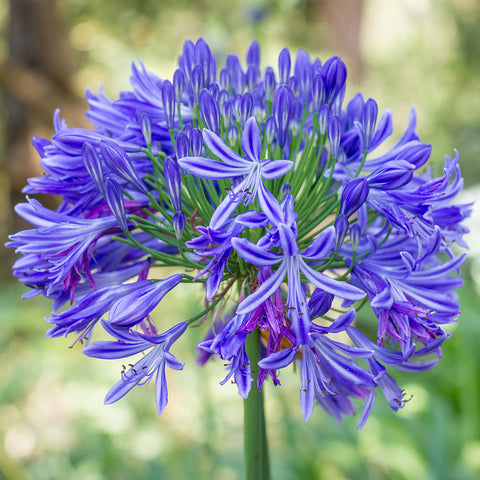Seasonal Agapanthus Care: Planning For Winter and Summer season
Seasonal Agapanthus Care: Planning For Winter and Summer season
Blog Article
Grasping the Art of Agapanthus Treatment: Necessary Steps for Healthy Development and Vibrant Flowers
In the realm of horticulture, the farming of agapanthus stands as a gratifying undertaking for those that seek to nurture these stylish flowering plants. From selecting the appropriate range to mastering pruning methods, the trip towards growing thriving agapanthus plants is multifaceted and holds the crucial to unlocking the complete possibility of these agricultural treasures.

Selecting the Right Agapanthus Range

When choosing the best Agapanthus variety for your yard, take into consideration aspects such as climate suitability, flower color, and development behavior. Agapanthus, frequently referred to as Lily of the Nile or African lily, comes in a range of colors varying from tones of blue and purple to white. Pick a blossom color that matches your existing garden palette to develop an unified landscape. In addition, take into consideration the climate in your area to make sure the Agapanthus range you select can grow in your details conditions. Some selections are a lot more tolerant of cold temperatures, while others choose warmer environments. Recognizing the growth behavior of different Agapanthus ranges is vital for proper placement within your garden. Some selections have a clumping development practice, ideal for containers or borders, while others have a more dispersing nature, ideal for ground cover or mass growings. By very carefully reviewing these elements, you can pick the best Agapanthus range to boost the elegance of your yard.
Ideal Planting Conditions
Considering the ideal ecological needs is essential for successful Agapanthus cultivation. Agapanthus plants are delicate to cold temperatures and ought to be safeguarded from frost during winter season months.
To make sure healthy growth and dynamic flowers, plant Agapanthus bulbs at a deepness of regarding 2-4 inches and area them 8-12 inches apart. Including organic issue, such as garden compost, to the dirt can improve drain and fertility, advertising robust origin development. Mulching around the base of the plants helps keep moisture and suppresses weed growth. Normal watering is important, particularly throughout the growing period, to keep the dirt consistently damp however not soaked.
Watering and Feeding Tips
Maintaining proper dampness levels and supplying vital nutrients are crucial elements in the care routine for Agapanthus plants. It is crucial to strike an equilibrium when it comes to sprinkling Agapanthus. These plants favor constantly damp soil yet are prone to root rot if overwatered. During the growing period, water deeply when a week, making certain the soil is well-draining to protect against waterlogging. In hotter environments or throughout periods of dry spell, even more regular watering may be necessary to keep the dirt uniformly wet. Nevertheless, minimize watering in the winter to stop waterlogged conditions.
Feeding Agapanthus is vital for advertising healthy and balanced growth and respected blossoms. Apply a balanced plant you can check here food, such as a 10-10-10 formula, in the very early springtime as brand-new development emerges. Repeat this application every 6-8 weeks throughout the growing season. Stay clear of excessive fertilizing, as it can result in lavish vegetation at the cost of blossoms. Always adhere to the producer's instructions for appropriate dilution and application approaches. By following these watering and fertilizing suggestions, you can guarantee your Agapanthus plants thrive and create lively, long-lasting flowers.
Pruning Techniques for Agapanthus
Pruning Agapanthus plants at the ideal times and with correct strategies is important for maintaining their health and wellness and advertising optimal development and flowering. The suitable time to trim Agapanthus is in late winter or very early spring prior to brand-new growth arises.
Deadheading spent flowers can additionally reroute the plant's power right into creating even more flowers instead than setting seeds. If you want to gather seeds for propagation, leave some blossoms to completely dry and mature on the plant.
Remember to utilize tidy, sharp tools to make accurate cuts and lower the risk of presenting conditions. Agapanthus. Regular trimming will check this certainly help maintain your Agapanthus looking neat and healthy while guaranteeing a plentiful display of lovely blossoms
Handling Common Bugs and Illness
After making sure appropriate pruning techniques for Agapanthus, it is necessary to resolve typical bugs and diseases that can influence the wellness and vigor of these plants. Agapanthus plants are normally hardy but can still come down with certain concerns. One typical bug that affects Agapanthus is the Agapanthus gall midget. This little, orange fly lays its eggs in the vegetation, causing altered development and blossom buds that fail to open. To fight this insect, trim and destroy any affected plant components and consider making use of insecticidal soap.
In addition, Agapanthus plants can experience from origin rot if they are grown in poorly draining pipes dirt. By being watchful and taking prompt activity against parasites and conditions, you can aid your Agapanthus plants flourish and generate vibrant blossoms. Agapanthus.

Verdict
In verdict, understanding the art of agapanthus care involves picking the appropriate variety, offering optimal planting problems, correct watering and fertilizing, suitable pruning techniques, and resolving usual parasites and conditions. By adhering to these crucial actions, you can make certain healthy and balanced development and dynamic blooms for your agapanthus plants. Keep in mind to routinely keep an eye on and preserve your plants to promote their total well-being and long life.
To guarantee healthy development and vibrant blooms, plant Agapanthus bulbs at a deepness of concerning 2-4 inches and space them 8-12 inches apart. By complying with these watering and feeding pointers, you can guarantee your Agapanthus plants flourish and generate vibrant, durable blossoms.
One typical bug that impacts Agapanthus is the Agapanthus gall midget. Additionally, Agapanthus plants can suffer from use this link root rot if they are planted in inadequately draining pipes soil. By following these essential steps, you can make certain healthy growth and vivid blossoms for your agapanthus plants.
Report this page